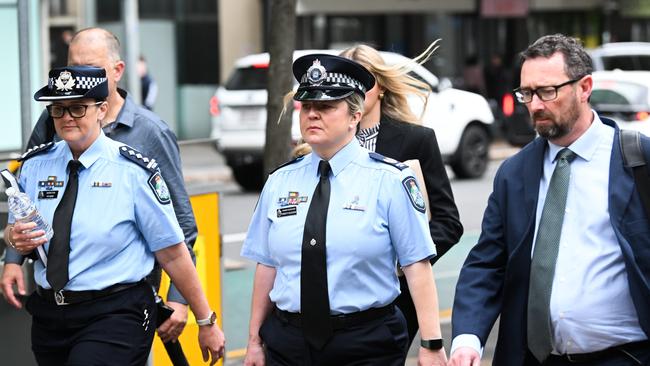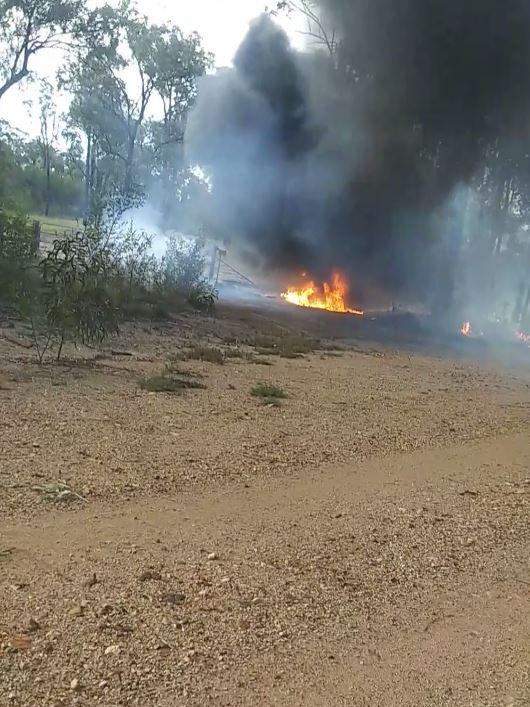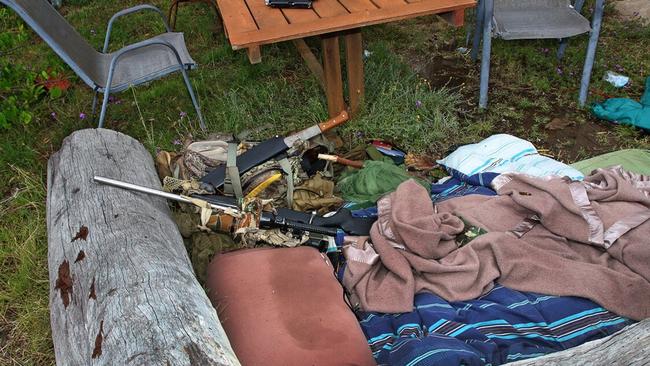Makeshift barricade, mirrors: Inside cop killers’ deadly confrontation with tactical police
An inquest has revealed weird details inside the “off-grid” property of a trio of cop killers, including how they barricaded their home.

A trio of shooters were living “off-grid” with little electricity and tank water, stockpiling weapons and even placing a bizarre item with an expletive message on their letterbox, a court has been told.
The coronial inquest into the deadly massacre at Wieambilla is now going inside the deadly siege by tactical police who swarmed the rural Queensland property in response.
Evidence has already been given that a “barricade” was placed on the road to slow down a heavily armoured vehicle and used mirrors to disorient responding police.
Queensland Police constables Rachel McCrow, 29, and Matthew Arnold, 26, were murdered by members of the Train family – Nathaniel, Gareth and Stacey – at the Wains Rd property on December 12, 2022.


The Trains’ neighbour Alan Dare, 58, was also murdered investigating fires lit by the group.
Two other constables – Keely Brough and Randall Kirk – survived.
All three members of the Train family were killed by highly trained special emergency response team (SERT) officers during a lengthy shootout later that night.
On Tuesday senior police revealed the extent of the Trains’ planning in response to the responding SERT teams.
Senior Sergeant Kirsty Gleeson, the forensics co-ordinator for the Southern Region, told the court the Trains’ property appeared designed for “off-grid living” when she conducted a walk through of the Wains Rd property.
The Trains’ home had no main-line electricity – only solar panels connected to the roof of the laundry.
Several water tanks are also located around the property.
Sergeant Gleeson said the home was sparsely furnished and there was no landline phone connected to the house.
Spent ammunition cartridges and bullets littered the rooms.
A security camera was located up a tree on the road to the property, connected to a battery.


It was not clear if it was operational at the time, Sergeant Gleeson said.
She said a black mug with the words “Have a Nice Day” was glued to the letterbox and inside it was an iPhone with a smashed screen.
A small scrawling was found at the top of the phone that contained an expletive word.
One hundred and sixteen discharged cartridges from non-QPS firearms were found around the Trains’ property.
However, investigators could not determine if all of these had been fired on the night of the siege.
Sergeant Gleeson said Constable Arnold’s Glock pistol was found on a table near the house.
The court was told a round had been fed through the chamber, indicating the gun had jammed.
Another six cartridges were found near the L-shaped log where Nathaniel had been shooting from after he had switched from his rifle to using the pistol.
Sergeant Gleeson said investigators were able to recover some bullet fragments from Mr Dare’s body, but they were not able to determine which firearm had been used to shoot him.
The court was told it was likely Nathaniel had initially shot both constables from the property’s main sniper hide-out due to his DNA being found on items there.


Detective Senior Sergeant Nathan McCormack, who was the lead investigator into the deadly siege, gave evidence on Tuesday how the Trains had modified their property, including placing a “barricade” to hamper the SERT team’s BearCat vehicle as it drove towards the house.
The barricade – consisting of logs and metal – was placed on a curve in the road leading to the house in a bid to slow down the vehicle.
Aerial images presented in court showed the extent of the Trains’ modifications to the property – including establishing an “observation point” in vegetation.
The court was told several felled trees were also held by rope.
Another image captured after the siege on December 13 displayed patches of burnt vegetation.
Sergeant McCormack said the “horseshoe” shape of the fires was advantageous to the Trains due to the heat and smoke hindering some of the SERT teams.
Earlier in the inquest, the court was told these fires were lit by the Trains to flush out Constable Brough as she hid in grassland.
Sergeant McCormack said Team 2 from SERT followed the BearCat vehicle onto the property.
The same team flanked the BearCat after it breached a barricade to the Trains’ property.


Sergeant McCormack said several mirrors were also placed around the driveway and near the log.
He explained they reflected the headlights of the approaching BearCat and hampered SERT officers’ approach.
Several CDs were found in various places around the property, including the fence.
Sergeant McCormack said he couldn’t speculate on why this was the case but suggested it was because the CDs had a similar “reflective” surface.
Gareth also used a large hunting light to further disorient the BearCat as it approached, the court was told.
It was during this time the Trains were able to open fire on the BearCat – some rounds striking the vehicle’s windshield.
The court was told Gareth continued to fire intermittently at SERT teams for about 40 minutes before police returned fire just after 10pm.
He was shot and killed about 30 minutes later.
Sergeant McCormack told the court that Ms Train fired only three shots throughout the siege from the house, while Nathaniel switched from his rifle to one of the Glocks he took from the slain constables.

Sergeant McCormack said he was able to develop a “chronology” of events using the footage to determine how the incident unfolded.
He gave evidence he then interviewed operatives involved and conducted walk-throughs of the Trains’ property.
“It was just to keep it fresh in their minds and obtain the correct version as quickly as possible,” Sergeant McCormack said.
Police officers gave evidence earlier in the inquest of their actions responding to the shooting, including the recovery of the slain constables and Mr Dare.
Sergeant McCormack said 19 SERT operatives – including the then commander Tim Partridge – were deployed in response to the Wieambilla incident.
They included three light armour vehicles, the BearCat and four negotiators.
Loudspeakers were used to negotiate with the Trains in vain and calls were made to their phones, Sergeant McCormack said.


He told the court different radios had to be used due to the Trains taking the slain constables’ radios.
On one side of the Trains’ house, an L-shaped log was positioned close to the steps where Nathaniel and Gareth were firing on police.
An image was shown to the court displaying one of the rifles positioned on the log, along with bags, blankets and a large hunting knife.

Attending police were ambushed by the brothers while conducting a welfare check on Nathaniel, a former NSW school principal who had been reported missing months prior.
The Trains followed an extremist Christian ideology known as premillennialism, believing Jesus Christ would return to earth after a period of extreme suffering.
The inquest continues.


